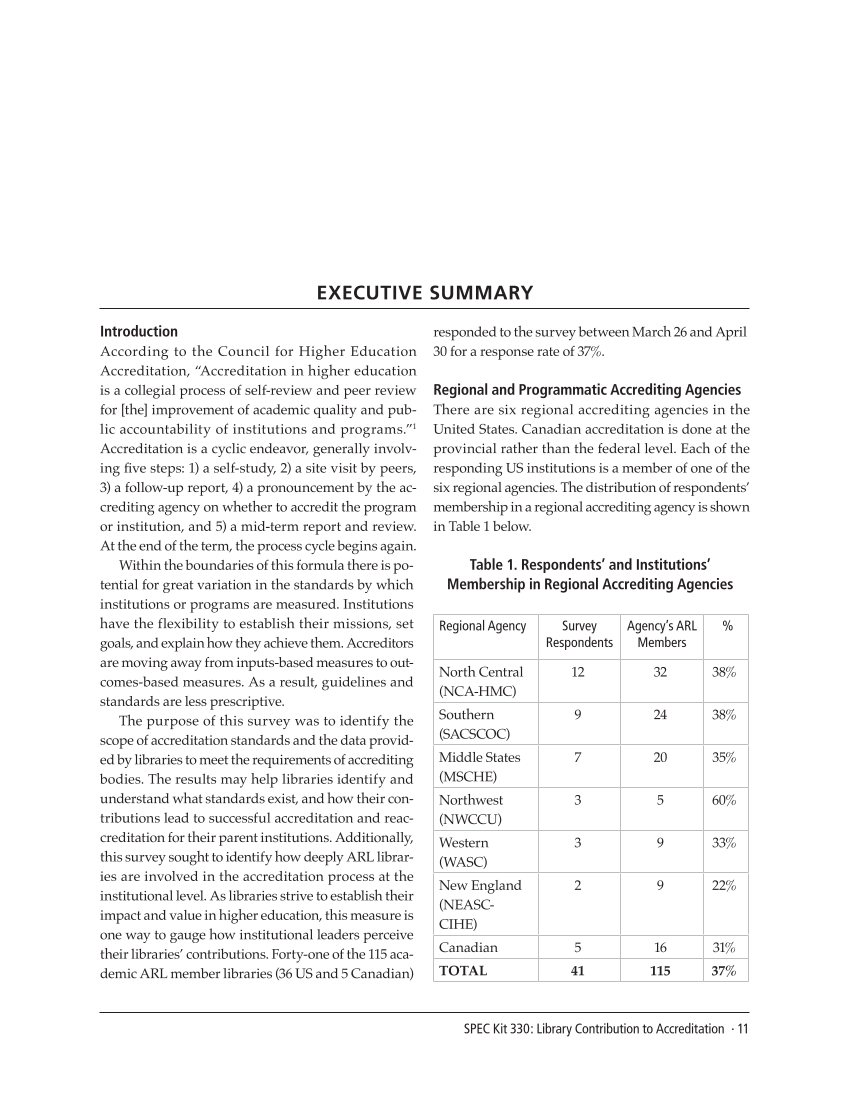SPEC Kit 330: Library Contribution to Accreditation · 11
Executive Summary
Introduction
According to the Council for Higher Education
Accreditation, “Accreditation in higher education
is a collegial process of self-review and peer review
for [the] improvement of academic quality and pub-
lic accountability of institutions and programs.”1
Accreditation is a cyclic endeavor, generally involv-
ing five steps: 1) a self-study, 2) a site visit by peers,
3) a follow-up report, 4) a pronouncement by the ac-
crediting agency on whether to accredit the program
or institution, and 5) a mid-term report and review.
At the end of the term, the process cycle begins again.
Within the boundaries of this formula there is po-
tential for great variation in the standards by which
institutions or programs are measured. Institutions
have the flexibility to establish their missions, set
goals, and explain how they achieve them. Accreditors
are moving away from inputs-based measures to out-
comes-based measures. As a result, guidelines and
standards are less prescriptive.
The purpose of this survey was to identify the
scope of accreditation standards and the data provid-
ed by libraries to meet the requirements of accrediting
bodies. The results may help libraries identify and
understand what standards exist, and how their con-
tributions lead to successful accreditation and reac-
creditation for their parent institutions. Additionally,
this survey sought to identify how deeply ARL librar-
ies are involved in the accreditation process at the
institutional level. As libraries strive to establish their
impact and value in higher education, this measure is
one way to gauge how institutional leaders perceive
their libraries’ contributions. Forty-one of the 115 aca-
demic ARL member libraries (36 US and 5 Canadian)
responded to the survey between March 26 and April
30 for a response rate of 37%.
Regional and Programmatic Accrediting Agencies
There are six regional accrediting agencies in the
United States. Canadian accreditation is done at the
provincial rather than the federal level. Each of the
responding US institutions is a member of one of the
six regional agencies. The distribution of respondents’
membership in a regional accrediting agency is shown
in Table 1 below.
Table 1. Respondents’ and Institutions’
Membership in Regional Accrediting Agencies
Regional Agency Survey
Respondents
Agency’s ARL
Members
%
North Central
(NCA-HMC)
12 32 38%
Southern
(SACSCOC)
9 24 38%
Middle States
(MSCHE)
7 20 35%
Northwest
(NWCCU)
3 5 60%
Western
(WASC)
3 9 33%
New England
(NEASC-
CIHE)
2 9 22%
Canadian 5 16 31%
TOTAL 41 115 37%
Executive Summary
Introduction
According to the Council for Higher Education
Accreditation, “Accreditation in higher education
is a collegial process of self-review and peer review
for [the] improvement of academic quality and pub-
lic accountability of institutions and programs.”1
Accreditation is a cyclic endeavor, generally involv-
ing five steps: 1) a self-study, 2) a site visit by peers,
3) a follow-up report, 4) a pronouncement by the ac-
crediting agency on whether to accredit the program
or institution, and 5) a mid-term report and review.
At the end of the term, the process cycle begins again.
Within the boundaries of this formula there is po-
tential for great variation in the standards by which
institutions or programs are measured. Institutions
have the flexibility to establish their missions, set
goals, and explain how they achieve them. Accreditors
are moving away from inputs-based measures to out-
comes-based measures. As a result, guidelines and
standards are less prescriptive.
The purpose of this survey was to identify the
scope of accreditation standards and the data provid-
ed by libraries to meet the requirements of accrediting
bodies. The results may help libraries identify and
understand what standards exist, and how their con-
tributions lead to successful accreditation and reac-
creditation for their parent institutions. Additionally,
this survey sought to identify how deeply ARL librar-
ies are involved in the accreditation process at the
institutional level. As libraries strive to establish their
impact and value in higher education, this measure is
one way to gauge how institutional leaders perceive
their libraries’ contributions. Forty-one of the 115 aca-
demic ARL member libraries (36 US and 5 Canadian)
responded to the survey between March 26 and April
30 for a response rate of 37%.
Regional and Programmatic Accrediting Agencies
There are six regional accrediting agencies in the
United States. Canadian accreditation is done at the
provincial rather than the federal level. Each of the
responding US institutions is a member of one of the
six regional agencies. The distribution of respondents’
membership in a regional accrediting agency is shown
in Table 1 below.
Table 1. Respondents’ and Institutions’
Membership in Regional Accrediting Agencies
Regional Agency Survey
Respondents
Agency’s ARL
Members
%
North Central
(NCA-HMC)
12 32 38%
Southern
(SACSCOC)
9 24 38%
Middle States
(MSCHE)
7 20 35%
Northwest
(NWCCU)
3 5 60%
Western
(WASC)
3 9 33%
New England
(NEASC-
CIHE)
2 9 22%
Canadian 5 16 31%
TOTAL 41 115 37%
























































































































































































